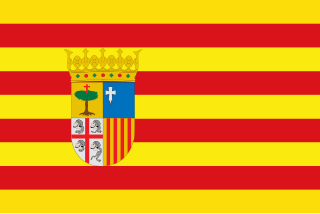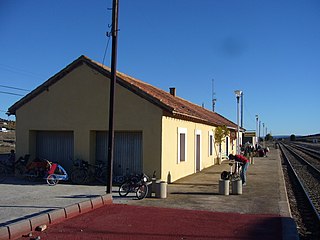
Aragon is an autonomous community in Spain, coextensive with the medieval Kingdom of Aragon. In northeastern Spain, the Aragonese autonomous community comprises three provinces : Huesca, Zaragoza, and Teruel. Its capital is Zaragoza. The current Statute of Autonomy declares Aragon a historic nationality of Spain.

Zaragoza also known in English as Saragossa, is the capital city of the province of Zaragoza and of the autonomous community of Aragon, Spain. It lies by the Ebro river and its tributaries, the Huerva and the Gállego, roughly in the centre of both Aragon and the Ebro basin.

Teruel is a city in Aragon, located in eastern Spain, and is also the capital of Teruel Province. It had a population of 35,900 as of 2022, making it the least populated provincial capital in Spain. It is noted for its harsh climate, with a wide daily variation on temperatures and its renowned jamón serrano, its pottery, its surrounding archaeological sites, rock outcrops containing some of the oldest dinosaur remains of the Iberian Peninsula, and its famous events: La Vaquilla del Ángel during the weekend closest to 10 July and "Bodas de Isabel de Segura" around the third weekend of February.

Daroca is a city and municipality in the province of Zaragoza, Aragon, Spain, situated to the south of the city of Zaragoza. It is the center of a judicial district.

Mozota is a small town and municipality in Zaragoza province 25 km southwest of Zaragoza, Aragon, Spain.

The Autovía A-23 is a motorway in Aragon, Spain.
Torrijo del Campo is a municipality located in the province of Teruel, Aragon, Spain. According to the 2018 census (INE), the municipality has a population of 447 inhabitants.

Villahermosa del Campo is a municipality located at the feet of the Sierra de Cucalón, in the province of Teruel, Aragon, Spain. According to the 2004 census (INE), the municipality has a population of 97 inhabitants.

Villarroya de los Pinares is a municipality located in the Maestrazgo region, province of Teruel, Aragon, Spain. According to the 2004 census (INE), the municipality had a population of 190 inhabitants.
Mainar is a municipality located in the province of Zaragoza, Aragon, Spain. According to the 2004 census (INE), the municipality has a population of 162 inhabitants.

Manchones is a municipality in the province of Zaragoza, Aragon, Spain. According to the Spanish Statistical Institute (INE), the municipality had a population of 123 inhabitants in 2010. The pueblo is in the comarca of Campo de Daroca, about 6 kilometres (3.7 mi) northwest of Daroca and just southeast of Murero in the Calatayud-Daroca depression. The Jiloca River passes to the west.

Muel is a municipality located in the province of Zaragoza, Aragon, Spain. According to the 2004 census (INE), the municipality has a population of 1,142 inhabitants. There are ruins of ancient Iberian settlements located within Muel's municipal term. These are known as Cabezo La Torre I and Cabezo La Torre II.
Villarreal de Huerva is a municipality located in the province of Zaragoza, Aragon, Spain. According to the 2010 census, the municipality has a population of 202 inhabitants.

Villarroya del Campo is a municipality located in the Campo de Daroca comarca, province of Zaragoza, Aragon, Spain. According to the 2004 census (INE), the municipality has a population of 80 inhabitants.

Seno is a municipality located in the Bajo Aragon area, close to Maestrazgo in province of Teruel, Aragon, Spain, at an altitude of 792 m. According to the 2018 census the municipality has a population of 39 inhabitants.
Alvia is a high-speed train service in Spain offered by Renfe Operadora on long-distance routes with a top speed of 250 km/h (160 mph). The trains have the ability to use both Iberian gauge and standard gauge, which allows them to travel on the recently constructed high-speed lines for part of the journey before switching to the "classic" Iberian gauge network to complete it. Trains that run exclusively on high-speed tracks are branded AVE or Avant.

The Jiloca is a river in Aragón, Spain, a tributary of the river Jalón, and part of the watershed of the Ebro basin. The course of the river runs through the provinces of Teruel and Zaragoza. It has a length of 126 kilometres (78 mi) and an average flow rate of 2.1 cubic metres per second (74 cu ft/s), although this varies between the seasons. The river flows in a generally north easterly direction from its source near Monreal del Campo.

Valencian Gothic is an architectural style. It occurred under the Kingdom of Valencia between the 13th and 15th centuries, which places it at the end of the European Gothic period and at the beginning of the Renaissance. The term "Valencian Gothic" is confined to the Kingdom of Valencia and its area of influence, which has its own characteristics.

The Escandón Pass is a mountain pass in Teruel Province, Aragon, Spain. It is located in La Puebla de Valverde municipal term, in the Sierra de Gúdar and Sierra de Javalambre zone, where the Iberian System ranges begin to descend towards the sea.

The Ojos Negros Greenway, is a 160-kilometre greenway in Spain running between the village of Santa Eulalia del Campo in the province of Teruel in Aragón and the village of Algimia d'Alfara, in the province of Valencia in the Valencian Community.


















